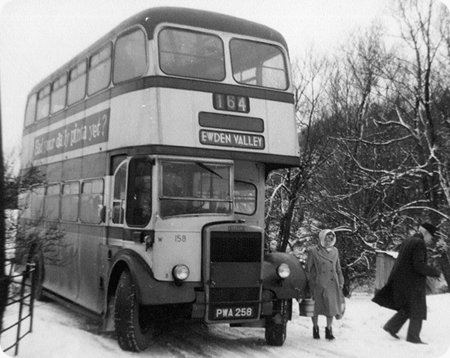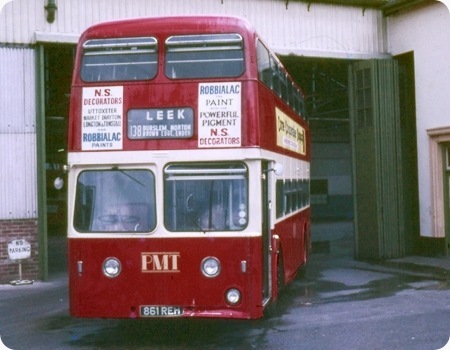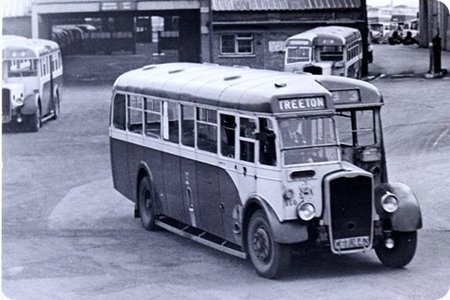Sheffield Corporation – Leyland Titan PD2 – PWA 258 – 158
Sheffield Corporation
1953
Leyland PD2/12
Weymann H32/26R
Sheffield operated a number of occasional services to small villages and hamlets to the north west of the City. Ewden Valley Village lay about a mile off the main Sheffield to Stocksbridge route 57 via a Sheffield Corporation Waterworks private road and was primarily home to workers at the adjacent reservoir. Service 164 was sparse but included this Saturday morning journey taken in February 1963 with a few villagers complete with shopping leaving Weymann bodied Leyland PD2/12 at the terminus in the snow. The bus which was allocated to Herries Road Garage was one of the 1953 B fleet batch of 26 such buses originally numbered 142-167 but renumbered later in 1963 with the addition of 2000 to their fleet numbers.
Photograph and Copy contributed by Ian Wild
24/02/11 – 08:10
Coincidence. Was just looking at 687 on the South Yorkshire site before I came here to find 158.
Ewden Valley is part of the beautiful Sheffield "Lake District" of reservoirs (and forestry) to the north of the city. Originally part of the West Riding, the area came into the city with the 1974 Local Government reorganisation.
Note the treacherous conditions with "raw" snow. At least the driver had a manual gearbox to help him cope. I drove part time for Reading Mainline in the ’90s and remember a happy Saturday morning in Reading when none of the side roads had been gritted. [I had never been skating before this…..]
David Oldfield
24/02/11 – 09:19
I worked in Sheffield during that winter. I can’t remember the buses ever stopping, but perhaps they did. I don’t think I missed a day’s work. This bus has- it seems- reversed into its terminus gritless. Presumably with a gentle bit of clutch work it will set off on that lock? Are today’s buses not gritless but gutless- these people wouldn’t have seen one for weeks? Despite the weight at the rear, does the transmission stop them getting a grip or are they just too long to control and the rear weight just makes them jack-knife?
Joe
24/02/11 – 10:11
Joe, I lived through some pretty harsh Sheffield winters in my childhood – notably 1962. Once the ploughs and gritters had been out, the buses emerged. The STD buses very rarely failed the burghers of Sheffield.
With a clutch there is far more control than any sort of automatic gives. This is one reason that all STD buses from 1951 to 1959 were manual. (The advent of "no-choice" on Atlanteans and Fleetlines put an end to this – and possibly the fact that the Atlantean killed off the last trams and was easier to convert tram drivers.)
David Oldfield
24/02/11 – 10:13
Joe – Many of us older drivers know that, in snow, you need grip, not power. The answer is to pull away and accelerate in a higher gear than usual, easy with a manual gearbox.
Also, modern buses have smaller wheels, I’m sure, so a smaller ‘footprint’ in the snow.
There may be other considerations, too, of which I can’t think offhand.
Chris Hebbron
24/02/11 – 21:33
What a handsome body was this penultimate Weymann style, before the advent of the "Orion". I believe that this style was heavier than the Orion, and that it continued after the 1954 Orion body and was known as "Aurora", availability continuing until the late 50s. In fact, Bournemouth`s MF2B trolleys owe much to this design. Not sure about my facts here, if anyone can clarify, but, as an enthusiast, I remember their gradual demise with some regret. They were, in my view, the most handsome of all bus bodies, and were a real "classic", their ancestry being traceable back to the first Weymann metal bodies of 1933. A truly evocative photograph!
John Whitaker
24/02/11 – 21:58
In reply to Joe, I am pretty sure that the bus as pictured had driven in to that position, it would reverse to the right of the photo before returning to the main A616 and the City down the private road which is to the left of the picture.
The nearest bus route to my home was on a pretty steep hill and I can remember in the snow drivers would go as slow as possible at the bus stop whilst the passengers jumped on the rear platform. Rarely did the buses miss in those days. My first two winters at work were 1962 and 1963. The first I was at Rotherham, the second on the edge of Sheffield City Centre, as well as two nights a week at night school. I cannot remember missing either work or night school during those winters due to the weather. I remember the single skin upper saloon domes with ice on the inside – no saloon heaters in those days!
Ian Wild
25/02/11 – 08:38
Rochdale received the Aurora on Regent Vs until 1959 (including the famous Gardners in about 1956) and Bournemouth was receiving the Sunbeams until 1962. The Bournemouths were the same design – except they had five short bays – just as the Rotherham CVG6s, contemporary to 158, had five short bays (and were also 7’6" wide).
The Orion is much maligned – often unfairly – but there is no doubt that this is a far better and more attractive design. Only the roof of the domes was single skinned on the Aurora. Around the front (and front side) windows was double skinned, as was the area around the rear emergency exit. All of this area was single skinned on the Orion.
As I’ve said before, the first upper deck heating on STD buses was the 1325-1349 Regent V/Roes of 1960.
David Oldfield
25/02/11 – 09:37
I can’t quite work it out on the photo, and it might be a trick of the eye with dirt/snow along the bottom, but does this body have the Weymann flair? If so, it would be quite late to have this feature.
Chris Hebbron
25/02/11 – 11:18
Yes, 158 had the Weymann flaired skirt. Also, PD2’s 668 to 687 of 1953 and 688-723 of 1954 had the flair. Straight ‘skirts’ were fitted to this body style for the Regent 3’s of 1954, nos. 178-199, 724-735 and 1154-55. Further deliveries thereafter were Orions.
John Darwent
28/02/11 – 06:59
This body design came out in 1952 or 1953. I have been aware for some time that Croft of Glasgow built similar-looking bodies, and have always assumed that they were Weymann-based – until I discovered that Croft were actually building them several years before Weymann! The one at this link must have looked incredibly modern in 1949.
Peter Williamson
02/03/11
Thanks for the Albion-Croft link, Peter W. The Croft body’s modern look is emphasized by the wonderfully thirties-looking Albion chassis–especially the radiator!
Ian Thompson
06/03/11 – 08:18
The Rochdale 1959 Regent V’s were probably the final incarnation of the Aurora design and what magnificent vehicles they were. When originally delivered in Rochdale’s majestic blue and cream streamlined livery they looked superb. The last four 319-322(TDK 319-322) had platform doors, believed to have been added to the spec so as not to be outdone by Bury Corporation whose Orion bodied PD3’s had this feature and operated on the joint routes 19 and 21T between the two towns. Compared to the Bury vehicles which I always found noisy and rough, the Rochdale Regent V’s with their semi-automatic gearboxes, were much more refined.
One of these vehicles was preserved at Sheffield Bus Museum. Is it still there? One of the 1956 Gardners is in the collection at Boyle Street, Manchester.
Philip Halstead
06/03/11 – 09:09
Yes, it’s still at Rotherham. [The museum moved!]
David Oldfield
07/03/11 – 09:27
I remember the Rochdale Regent Vs (and the preceding Daimlers with basically similar bodies) very well as I used to use the 17 service in Manchester regularly. What impressed me even more than the features Philip mentions was the interiors. They were fairly basic really, with leatherette seats and painted metal window cappings, but who would have thought that two shades of blue, together with a strangely translucent white on the ceiling, could be so restful? With those colours, the smoothness of the drive train and the soporific crooning of the transmission, a 12-minute journey on one of those was almost enough to induce an altered state of consciousness!
Peter Williamson
12/03/11 – 08:00
I agree with Peter, the Rochdale interiors were plain but very clean and fresh feeling. As a child I was a bit susceptible to travel sickness and somehow the Rochdale interiors seemed to calm my problem. It is surprising how interior features stick in ones mind from those childhood days. Manchester’s ‘standard’ bodies were very dark and oppressive inside with dark moquette seats and dark varnished woodwork. In the days of almost universal adult smoking the moquette seating seemed to soak up the stale tobacco fumes even in the lower saloon. We used to travel into Manchester from Rochdale on the 24/90 service, jointly worked by Manchester, Oldham and Rochdale corporations and I would always hope our bus would be a Rochdale vehicle.
The Oldham buses had some distinctive internal features I well remember. Hanging leather straps in the lower saloon with handles similar to horse-riding stirrups. A row of domestic style Bakelite light switches with porcelain fuse holders on the front lower saloon bulkhead above the driver’s cab window. The words ‘Oldham Corporation’ were emblazoned across the front bulkhead in gold lettering – civic pride still existed in those days! And finally the ‘Honesty Box’ on the rear platform. Did anybody ever put anything into it, I wonder? I also remember the Oldham Roe bodies were a bit short on bell pushes in the upper saloon and conductors would give the starting signal from the front with a couple of heavy stamps of the foot on the floor above the cab!
We seem to concentrate our interest in the exteriors of buses but not much is written or photographed about the insides.
Philip Halstead
13/03/11 – 08:05
Philip, I fully agree regarding bus interiors. That was the environment in which you travelled, and it was often very distinctive – location and style of bell pushes (or cords or strips), pattern of light fittings (before the arrival of standard fluorescent strip lights), seats and upholstery – even smells. Perhaps there are a few more interior shots out there to add another dimension?
Stephen Ford
04/06/18 – 07:03
This is a few years after Stephen’s comment which I’ve only just read, but with regard to ‘smells’, I used to love getting a green West Riding tin-front Guy from Sheffield to Ecclesfield back in the 1950’s. Unlike the STD buses, they were cleaned with a pleasant, perfumed disinfectant which I can still ‘smell’ to this day.
At that time, I think both West Riding and Yorkshire Traction buses carried posters on the windows stating ‘Cut the fuel tax. We don’t like it, you don’t like it, it must GO!’. Anyone else remember that ?
Mike C



